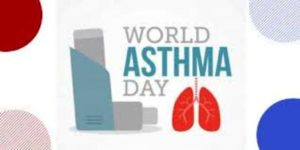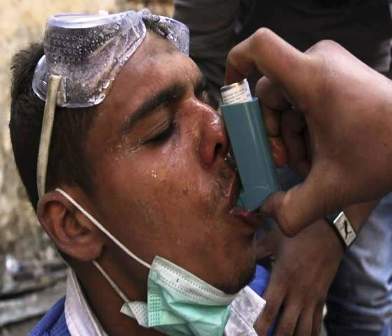-
World Asthma Day 2020 Special Interview: Part 2

In this second part of the special interview to mark the 2020 World Asthma Day, Professor Gregory Erhabor, a professor of Medicine and Consultant Chest Physician at the Obafemi Awolowo University/ Obafemi Awolowo University Teaching Hospital Complex, Ile-Ife, Nigeria, discusses strategies for asthma management in the raging COVID-19 pandemic and gives vital tips to assist individual asthmatics. Prof. Erhabor is also the President/Founder of Asthma and Chest Care Foundation, member, Council of Global Governors of the American College of Chest Physicians and the Editor-in-Chief of the West African Journal of Medicine. EXCERPTS
Are more asthmatics presenting with COVID-19?
Current observational research has shown that asthmatics do not come up with increased exacerbation during COVID-19. But this is still evolving because COVID-19 affects the parenchyma of the lungs rather than the lung airways. Perhaps asthma protects against COVID 19 via a different immune response elicited by the disease. ACE 2 receptor expressed in respiratory epithelium have been documented as the route of entry of SARS-Cov2 in humans. However, asthma patients have a decreased expression of these ACE2 receptors.
Therapies used by patients with asthma can reduce the risk of infection or of developing symptoms leading to diagnosis. Suppression of viral replication was shown, as the inhaled corticosteroid, ciclesonide, blocks coronavirus RNA replication by targeting viral NSP15. There have also been reports of the inhibitory effects of glycopyrronium, formoterol and budesonide on coronavirus HCoV-229E replication and cytokine production by primary cultures of human nasal and tracheal epithelial cells.
Now that getting medical attention is becoming more difficult for the asthmatics as the COVID-19 pandemic rages, what will be your advise to individuals living with asthma?
Management of asthma is usually a partnership between the physician and the patient with asthma. Asthmatics are encouraged to work with their physicians to develop a self-management plan which includes plan for acute exacerbation of asthma. Central to this management is the following:
- It must be individualized and personalized. There is need to study their asthma and treatment must be personalized for each person.
b) Education is paramount. They need to be educated on asthma, the different components of asthma, how to recognize their triggers, inhaler techniques, self- management plan, amongst others.
c) The early use of anti-inflammatory drugs which include inhalational steroids is advocated.
d) Reserving rescue medications only for acute exacerbation. The lesser they are used shows a good management of their asthma.
e) The use of combination therapy using long acting beta 2 agonists and inhaled corticosteroids (such as Budesonide/Formoterol, Fluticasone propionate/ salmeterol, Fluticasone propionate/ Formoterol etc) for long term maintenance of asthma. These medications can also be used as rescue medications. There are other newer drugs used in advanced countries but these are not readily available and affordable. However, with concerted efforts by pharmaceutical industries and interest by philanthropic bodies, we may be able to bridge the gap between the developing nations and more industrializes countries.
f) As a principle, it is advised to take inhaled medications for asthma because it gets delivered to the site of action, and small doses give maximum effect. However, some inhaled medications can cause oral thrush and this can be prevented by using spacer devices or rinsing the mouth immediately after use.
g) Monitoring of their asthma using a peak flow meter which allows them to calibrate their asthma because the peak flow meter has a colour-coded portion red, yellow and green. The Green zone shows you have good control, no asthma symptoms and you can continue to take your medications as usual. Your peak flow reading at this time is between eighty to hundred percent of your normal readings. The Yellow Zone is termed the zone of caution! The patient may have cough, wheeze, chest tightness or shortness of breath. He or she may be waking up at night due to asthma and can do some, but not all, usual activities. Use your inhaled bronchodilator with your anti-inflammatory medications and you may think of either changing medications or increasing dose. The Red Zone is the medical alert! The patient is usually very short of breath and quick-relief medicines have not helped. That person needs urgent attention.
h) They should notice when their asthma is deteriorating for instance (i) when they have increasing symptoms of cough, wheeze, chest tightness and breathlessness, in spite of their usual medications (ii) when they have to use increasing doses of their usual drugs, (iii) when they have to use additional drugs to be able to sustain a certain level of control, (iv) when they have to wake up at night because of asthma symptoms or have to wake up more nights in a week because of asthma (v) increasing environmental triggers or stressful events that may increase their asthma (vi) when they find it increasingly difficult to do exercise or get breathless on mild to moderate exercise.
i) A written self-management plan which will be personalized in case they have acute exacerbation of asthma.
Asthmatics should be managed as when there was no pandemic. When they notice deterioration in their health, they should contact the nearest health facility as soon as possible. The continual use of medications like aminophylline can be dangerous and should be discouraged. Early use of steroids is encouraged because of the anti-inflammatory properties.
How best can one manage a severe allergic reaction like cough or wheezing during the lockdown that wouldn’t be misconstrued or taken for symptoms of COVID-19?
As doctors, we usually say that all that wheezes is not asthma. However, wheezing is not one of the symptoms in COVID-19. Cough in COVID-19 is dry, continuous, associated with fever, sore throat, muscle aches, breathlessness and other constitutional symptoms. Cough in asthma is usually episodic, associated with wheeze, breathlessness, chest tightness, and triggered by exogenous factors. Having said this, the best way to have diagnosis for COVID-19 is to do the testing and tracking of symptomatic and exposed individuals. If you are having symptoms suggestive of COVID-19, report to centers responsible for testing, tracking and managing the disease. For asthma, diagnosis is from spirometry and demonstration of airway reversibility.

There was a recent report where the writer was trying to link asthma to COVID-19 given the fact that many suspected severe confirmed coronavirus cases are always placed on ventilator when they complain breathing challenge. What are the correlations between a non-communicable disease like Asthma and COVID-19?
A recent chat I had with colleagues from the American Thoracic society revealed no increasing events of asthma episode in the COVID-19 pandemic. The use of ventilator in COVID-19 has a lot to do with increase in the lung fluids or what we call acute respiratory distress syndrome (ARDS).
The use of ventilator in asthma is reserved for patients who have life threatening asthma (whose asthma has progressed from acute severe asthma, have low oxygen (hypoxemia), high level of carbon dioxide (hypercapnia), has a silent chest etc). These set of people must be managed in the intensive care unit. However, when they are on mechanical ventilator, they continue their medications such as bronchodilators, oxygen, anti-inflammatory medications and are also given additional medications like magnesium sulphate and heliox.
In carrying massive awareness campaigns on asthma management, what strategies would you suggest to reach those who actually need such education?
I met with a group of experts in Tromso, Norway, about two years ago and we were thinking of the use of ‘M’Health as a means of education, and managing patients with disease like asthma and COPD. ‘M’ Health is a term used for practice of medicine and public health supported by mobile devices like phones, tablets, computers, PDAs, variable devices that are smart etc. This is a very easy way in which you can use your smart device to track the patients; it also contains applications that can allow the patients to make informed decision on what to do and also connect with their physicians in very severe condition. That is an innovative step.
Other things that can be done include increasing public awareness through television, newspapers, radio, social media networks and using various public fora. There is also need for mass education in schools, churches and mosques and massive distribution of asthma information booklets.
What is the role of government in the care for asthma patients?
The government plays a major role in making policies that favour healthcare and establishment of standard healthcare facilities nationwide. They can mitigate the burden of asthma on patients and caregivers by subsidizing the cost of care for asthmatic patients. Government should also partner with non-governmental organizations like the Asthma and Chest Care Foundation in the provision of free or subsidized peak flow meters and nebulizers for asthma patients and in the production of ‘M’Health applications that can help patients in monitoring their asthma.
On a final note, we want to commend bodies like the Nigerian Thoracic Society headed by Prof. Prince Ele for the work done on asthma in Nigeria. The Asthma and Chest Care Foundation, my foundation, has also been in the forefront in the provision of education, patient care and counseling, training of health professionals; advocacy and conducting of research projects towards the enhancement of the lives of people with asthma and other lung diseases. We look forward to philanthropists who will support these bodies so as to augment the efforts of the government in asthma management.

